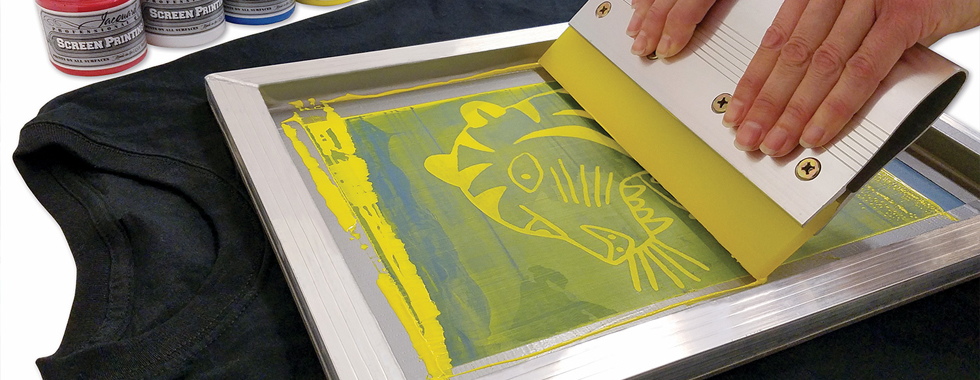The Vital Overview to Recognizing Screen Printing and Its Versatile Utilizes
Screen printing has a rich history that dates back to old times, advancing right into a sophisticated technique utilized throughout numerous industries today. This overview checks out the ins and outs of the screen printing process, describing its applications in style, marketing, and home design - 10:9 Design Screen Printing. Understanding these fundamentals can open creative possibility for both business and creative tasks. The complying with sections will certainly reveal vital suggestions and techniques to boost one's screen printing undertakings
The History of Screen Printing
Although screen printing has roots that trace back centuries, its development mirrors the technical and creative developments of different cultures. Coming from in old China, the strategy was at first made use of for enhancing fabrics and later infect Japan, where it ended up being important to Ukiyo-e woodblock printing. The approach shifted to Europe in the 18th century, where it acquired appeal amongst craftsmens and business printers. The innovation of picture solution in the 20th century transformed screen printing, permitting even more elaborate layouts and higher effectiveness. Artists like Andy Warhol additionally pushed its appeal, making use of the tool to develop iconic jobs that blended commercialism and great art. By the late 20th century, screen printing had developed itself as a functional method, utilized in vogue, advertising, and great art. Today, it remains to evolve, integrating digital innovation and increasing its applications throughout numerous sectors.
The Screen Printing Process Explained
Screen printing changes artistic visions right into tangible designs via a series of precise steps. Initially, a picture is produced and after that moved onto a screen, typically constructed from great mesh fabric extended over a frame. A light-sensitive solution is applied to the screen, which is revealed to light, setting in areas not covered by the image. After washing out the unhardened emulsion, a stencil is created.
Next, the screen is positioned over the substratum, whether it be material, paper, or an additional product. Ink is after that pushed via the open locations of the stencil utilizing a squeegee, transferring the design onto the substratum below. This process can be repeated for several colors, requiring separate displays for each and every color. The printed item is healed using warmth to ensure the ink adheres properly, resulting in a long lasting, vivid style ready for use.
Kinds Of Screen Printing Techniques

Additionally, specialized techniques, such as discharge screen printing, get rid of dye from the textile to develop softer prints, while foil screen printing uses metallic foil to accomplish a glossy surface (10:9 Design Screen Printing Texas). Each technique supplies unique features, dealing with various innovative demands and production ranges, inevitably increasing the possibilities within the screen printing domain
Applications of Screen Printing in Different Industries

Furthermore, the signage and advertising markets utilize screen printing for creating distinctive displays and banners. This approach enables for vibrant shades and complex designs that capture interest. In electronic devices, screen printing is utilized for applying conductive inks to motherboard, necessary for part connections. The home décor industry embraces screen printing to create distinct styles on textiles and wall art. In general, screen printing works as a click resources critical device across diverse fields, enhancing items with personalized and aesthetically appealing graphics.
Tips for Successful Screen Printing Projects
While embarking on a screen printing job, careful interest to information can substantially enhance the final end result. Initially, selecting high-grade products is vital; this includes the screen, inks, and substrates. Making use of appropriate mesh matters can impact ink deposition and detail resolution. Preparation is equally important; extensive cleansing of displays and correct exposure times ensure crisp prints.
Next, accurate registration is important for multi-color prints. Making use of placement devices can assist attain exact layering. In addition, testing prints on scrap materials before production helps identify potential concerns without squandering sources.

Regularly Asked Concerns
What Products Are Best for Screen Printing on Textile?
Cotton and polyester blends are ideal for screen printing on fabric because of their click to find out more durability and ink absorption. In addition, specialty materials like silk or canvas can generate one-of-a-kind textures and finishes, enhancing the total style quality.
How Do I Tidy and Maintain Screen Printing Devices?
To clean and maintain screen printing equipment, one ought to frequently wash screens with appropriate solvents, evaluate mops for wear, lubricate moving components, and shop all products in a completely dry, dust-free atmosphere to prolong their life-span.
What Are the Environmental Influences of Screen Printing?
Screen printing can have considerable ecological impacts, consisting of chemical waste from solvents and inks, water usage during cleansing procedures, and power usage. Environment-friendly products and sustainable practices are crucial for minimizing these negative effects.
Can Screen Printing Be Done in the house Effectively?
Screen printing can be successfully done at home with the right products and techniques. Enthusiasts can produce high quality prints, though success relies on their skill degree, tools, and understanding of the process included.
What Are the Prices Connected With Starting a Screen Printing Business?

Starting a screen printing company includes expenses for tools, products, and work space. Preliminary expenditures usually vary from a couple of hundred to several thousand dollars, relying on the scale, high quality of machinery, and wanted production capability.
Screen printing has a rich history that dates back to ancient times, advancing into an innovative strategy used throughout different industries today. An additional strategy, rotating screen printing, uses cylindrical screens, assisting in constant printing on material rolls, thus boosting efficiency for large-scale manufacturings. Furthermore, specialized techniques, such as discharge screen printing, get rid of dye from the textile to develop softer prints, while foil screen printing applies metal aluminum foil to achieve a glossy coating. In the style field, screen printing is extensively made use of to produce vivid designs on clothing, enabling brands to display their unique styles. Cotton and polyester blends are optimal for screen printing on material due to their resilience and ink absorption.